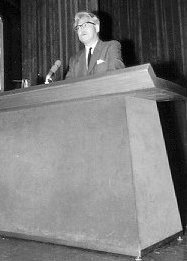机の形についていっても事態はよくなりません。わたしたちはみな、ものの「ほんとうの」形について判断する習慣をもっており、しかもこの判断をまったく無反省におこなうので、そのもののほんとうの形を実際に見ると思うようになります。しかし事実は、誰でも物のかたちを描こうとするとわかることですが、同一のものが視角が変るにつれて違った形に見えます。わたしたちの机が「ほんとうは」矩形(くけい)だとしても、ほとんどどの角度から見ても2つの鋭角と2つの鈍角をもっているように見えます。対辺は平行であっても、観察者には遠方の一点に収束するよう見えます。対辺は同じ長さですが、観察者に近い辺の方が長く見えます。このようなことはすべて机を見ても普通は気づきません。というのは、経験は外見上の形から「ほんとうの」形を構築することを教えてきたし、また「ほんとうの」形が実際家としてのわたしたちの関心を引くものだからです。だが「ほんとうの」形はわたしたちが見る通りのものではありません。それはわたしたちが見るものから推論されたものです。そして、わたしたちが見るものはわたしたちが部屋を歩きまわると絶えず形を変えます。ですから、ここでもまた感覚は、机そのものについての真理をあたえないで、机の外見についての真理だけをあたえるように見えます。(右写真:講演中の笠信太郎ラッセル協会初代会長/この演台は聴衆の見る位置によってさまざまな形に見えたことでしょう。)
同様な困難が触覚を考えるときにも起こります。机はいつも堅さの感じをあたえ、圧力に抗する感じがしますが、わたしたちの受ける感覚は机を圧す強さと机を圧す身体の部分によってちがってきます。ですから、ちがった圧力またはちがった身体の部分に応じてちがってくる感覚は、机の特定の性質を直接示すと考えることはできません。せいぜいのところおそらくすべての感覚をひき起こしはするけれども、そのどれにおいても実際には明白ではない、ある性質の記号と考えられるものです。同じことが、机を叩くときに出る音についていっそうはっきりといえます。
こうして、ほんとうにある机はもしあるとしても、直接見たり、さわったり、聞いたりして経験できるものと同じものではないことが明らかとなります。ほんとうの机はあるとしても決して直接知られるものではなくて、直接知られたものから推論されたものでなければなりません。ここからすぐつぎのような、二つの困難な問題が生じてきます。(1)そもそもほんとうの(実在する)机はあるのでしょうか。(2)あるとするとどのようなものでありうるでしょうか。
|
 The shape of the table is no better. We are all in the habit of judging as to the 'real' shapes of things, and we do this so unreflectingly that we come to think we actually see the real shapes. But, in fact, as we all have to learn if we try to draw, a given thing looks different in shape from every different point of view. If our table is 'really' rectangular, it will look, from almost all points of view, as if it had two acute angles and two obtuse angles. If opposite sides are parallel, they will look as if they converged to a point away from the spectator ; if they are of equal length, they will look as if the nearer side were longer. All these things are not commonly noticed in looking at a table, because experience has taught us to construct the 'real' shape from the apparent shape, and the 'real' shape is what interests us as practical men. But the 'real' shape is not what we see; it is something inferred from what we see. And what we see is constantly changing in shape as we move about the room ; so that here again the senses seem not to give us the truth about the table itself, but only about the appearance of the table.
The shape of the table is no better. We are all in the habit of judging as to the 'real' shapes of things, and we do this so unreflectingly that we come to think we actually see the real shapes. But, in fact, as we all have to learn if we try to draw, a given thing looks different in shape from every different point of view. If our table is 'really' rectangular, it will look, from almost all points of view, as if it had two acute angles and two obtuse angles. If opposite sides are parallel, they will look as if they converged to a point away from the spectator ; if they are of equal length, they will look as if the nearer side were longer. All these things are not commonly noticed in looking at a table, because experience has taught us to construct the 'real' shape from the apparent shape, and the 'real' shape is what interests us as practical men. But the 'real' shape is not what we see; it is something inferred from what we see. And what we see is constantly changing in shape as we move about the room ; so that here again the senses seem not to give us the truth about the table itself, but only about the appearance of the table.
Similar difficulties arise when we consider the sense of touch. It is true that the table always gives us a sensation of hardness, and we feel that resists pressure. But the sensation we obtain depends upon how hard we press the table and also upon what part of the body we press with; thus the various sensations due to various pressures or various parts of the body cannot be supposed to reveal directly any definite property of the table, but at most to be signs of some property which perhaps causes all the sensations, but is not actually apparent in any of them. And the same applies still more obviously to the sounds which can be elicited by rapping the table.
Thus it becomes evident that the real table, if there is one, is not the same as what we immediately experience by sight or touch or hearing. The real table, if there is one, is not immediately known to us at all, but must be an inference from what is immediately known. Hence, two very difficult questions at once arise; namely, (1) Is there a real table at all? (2) If so, what sort of object can it be?
|
 (初心者のページ)
(初心者のページ) (初心者のページ)
(初心者のページ)